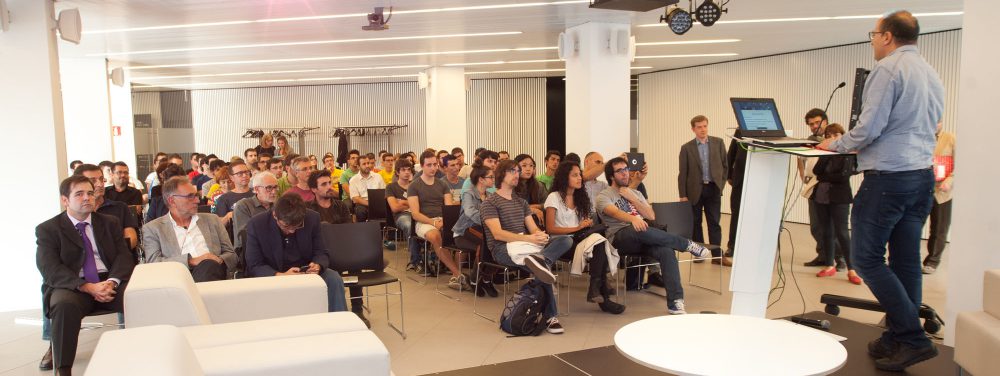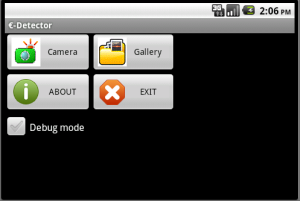Ongoing and supervised PhD’s Thesis Projects:
2019- : Impact and enhacement of the follow-up and care of cronic wounds using Artificial Intelligence. Author: David Reifs Jiménez. Tutors: Ramon Reig-Bolaño, Sergi Grau Carrión, Francesc García-Cuyàs.
This project is framed within the Industrial Doctorates Program from the Catalonia Government, within the collaboration agreement between the University of Vic – Central University of Catalonia and the Seidor Consulting SL Company.
More than 13M of people around the world suffer the effects of chronic wounds every year. The overall cost of these treatments is around 15B of dollars. The current demographic projections indicate clearly the increase in life expectancy, as well as a sensible reduction in births. The increase in life expectancy and longevity are the positive consecuence of the improvement in social development, and contribute to an important impact on the social and economic system, which is causing a reorganization of public investments in the socialcare and healthcare system. Chronic diseases and especially in the last part of life are becoming more frequent and will have a higher prevalence.
When speaking specifically about wounds, chronic wounds, ulcers, and any kind of long-term or non-healing skin-lesions, there is a clear lack of control and monitoring tools, which could contribute to the best management and treatment, also from the economic point of view, with mechanisms that do not saturate the healthcare system.
This project will explore the research challenge of the wound management using mobile devices, due to fact that the high resolution cameras on phones enable anyone to capture images with the same quality as a professional camera, toghether with the generalization of broadband communication systems and the evolution of mathematical models in terms of computer vision and the increasingly widespread incorporation of artificial intelligence-based control and analysis system.
Moreover this will open a business opportunity, thus leading to the incorporation of systems for the assisting in decision-making in the treatment and follow-up of wound injuries and reducing its social costs.
Finished supervised PhD’s Thesis Projects:
2014-2019: Integration of communication through mobile phone applications in a primary healthcare model based on interprofessional team. Author: Francesc Xavier Marin. Tutors: Francesc García-Cuyàs, Ramon Reig-Bolaño.
Analizing the use of mobile applications or apps in our country we discover more than 40,000 health-related apps on different platforms, and 70-80% of them are targeted to an average consumer, in Spain most of the users are male between 25 and 40 years, about 5 milion. On the other hand, there is an increasing degree of penetration of mobile telephony in developing countries, it is estimated that 79% of the population has access to them, these opens new ways to access the healthcare services that must be studied and foreseen.
Supervised Master’s Thesis Projects:
2014-15: Remote healthcare solutions by David Reifs
This project will be developed in a collaboration between Seidor Labs, Universitat de Vic – Universitat Central and Fundació Institut de Recerca Hospital de Sant Pau i de la Santa Creu.
The use of mobile apps on smartphones is revolutionizing the world, in special Healthcare sector. There is a growing interest and adoption in the use of mobile applications by patients and healthcare professionals as a part of wellness, prevention and treatment. The use of mobile devices by healthcare professionals has transformed may aspects of clinical practice. Mobile devices have become commonplace in health care settings, leading to rapid growth the development of medical software (apps) for these platforms. Mobile devices and apps provide many benefits for the healthcare professionals, perhaps most significantly increased access to point of care tools, which has been shown to support better clinical decision-making and improved patient outcomes.
This project will offer an insight into this potentially market, and will implement a complete solution in the Tremor diagnosis. The main idea is developing a project that we call Tremor Clinic. Tremor Clinic will be a medical platform aimed to provide a second opinion and medical counselling to patients affected by Tremor. We want to continue a project started on 2013-2014, based on the same medical idea and developed for Android Platform. We will implement the iOS version and also the intranet web site for Medical Staff and for Patients.
2013-14: Design and Development of a mobil Application for the detection of symptomaic gestures of Parkinson desease by Arnau Palma
This Final Master Project has created an application for smartphones with Android operating system to help prediagnosis online and offline Parkinson’s disease and other tremors through the accelerometer of the device.
The application proposes a series of tests postures with the phone placed on the back of the hand with a supporting bracalet. It can be run in four modes. To measure the tremor, it uses the Fast Fourier Transform formula. The result is shown in a graph. Three modes can be shared via email or social networks. There have been several tests with an expert in the tremor of the Hospital de la Santa Creu i Sant Pau in Barcelona consultation. Preliminary results show a high degree of overlap with those obtained using the apparatus of the Hospital.
Conclusions: The results are encouraging but is necessary to do a test with a larger sample of patients, and online testing to validate the results and improve the reliability of the application.
2011-12: Hand gesture recognition with Kinect sensor / Reconeixement de gestos de la mà amb el sensor Kinect by Elisabet Faja i Grau
Nowadays, Hand Gesture Recognition (HGR) is an important research field since there are many situations in which it is necessary to communicate through signs, for example communication between deaf and non-deaf people. In this project, a Real-Time Hand Gesture Recognition method with Kinect sensor for Xbox is presented. This system is implemented with Python under Linux using OpenCV computer vision library for data processing. Kinect sensor capacity to capture depth data enables 3D objects motion tracking, which allows the users to carry out complete real-time analysis of images or images sequences. Recognition process is based on image segmentation to remove background, which provides hand-processing only, contours detecting, convex hull and convex defects in order to determine the number of fingers and recognize hand gestures. Once the gesture has been recognized, the system will provide the correspondent output number or letter. The application can recognize numbers from 0 to 5, since only one hand is processed, many popular gestures and some letters of Catalan sign language alphabet. This project is, therefore, an introduction of Hand Gesture Recognition and the cradle of a future sign language recognition system able to transcribe both dynamic signs and sign language alphabet.
2011-12: Analysis of stereoscopic images with low computation methods Anàlisi d’imatges estereoscòpiques utilitzant mètodes de baixa càrrega computacional by Enric López i Rocafiguera
Using stereoscopic images, the position with regard to the camera of the objects appear in a scene, can be detected. From differences between the captured images by the two objectives we can determine the depth of objects. Diversity of computer vision techniques exists that allow you to calculate the location of the objects, usually with the aim to reconstruct the scene in 3D. These techniques require large computational burden, since they use two dimensional comparison methods, and therefore can not be used for real-time applications. In this project we propose a new method of analysis of stereoscopic images that allows us to obtain the depth of objects of a scene with acceptable results. This new method is based on transforming the two-dimensional image information into one-dimensional information in order to make a comparison of the images with a low computational cost, and use the comparison results to extract the depth of objects in the scene. This should allow, for example, this method can be implemented in a standalone device and allows doing guidance operations through indoor and outdoor spaces.
2010-11: Application of image recognition for mobile phones with Android also entitled Euro recognition Mobile integrated system by Anna Sebolewska
Image processing algorithms are a very popular area of research and it is a determinant subject in several fields like: medicine, real time application and normal life, in all of them there is an increasing demand of computer vision technology and artificial intelligence.
The biggest problem of image processing algorithms is their complexity and their high demand of computational resources. Moreover, some of them are more universal but others need a very specific and precise kind of input images.
The main aim of this diploma project is to create an application for Euro banknote recognition with new algorithms developed and created by the author and other algorithms related to more popular and well-known methods. The project shows that it is possible to implement sophisticated, greedy algorithms on mobile phone, with few memory and weak CPU resources and make complex tasks with simple tools and methods. The program is universal and does not need an specific kind of input images, in this way everybody with Android mobile phone or personal computer can try it.
The idea of the application is simple: the user makes a photo of an Euro banknote and the system recognises its amount. The banknote can be rotated, but it has to be on a plain background. The application analyses the image step-by-step, and the user can decide either to show every step of the algorithm, or directly go to the result of the recognition.
The project has two parts: the documentation and the implementation part. The documentation part is divided into descriptive and technical documentation. The implementation part comprises two versions. The first one is an application for Euro banknote recognition for Android OS and the other version is for other operating systems like Windows, Linux and MacOS. The code for the calculations is exactly the same in both cases, the difference is just in the graphical user interfaces. The application is downloadable at the Android Market (EuroRecognition). A blog with the project information is also available at http://euro-recognition.prv.pl
2009-10: Image analysis software for metallographic probes / Programa d’anàlisi d’imatges de provetes metal·logràfiques by Antoni Suriñach Albareda.
The aim of this Master Final Project is to explore the possibilities of the mathematical software MATLAB and its tool (GUIDE), developing a software of image analysis of metallographic specimens which can be used in laboratory practices of the subject Materials Technology given in the Mecatronic Engineering degree of the University of Vic. The interest areas of the project are the Virtual Instrumentation, MATLAB programming and the analysis techniques of metallographic images. In the written paper it is shown a special importance on the interface design and the procedures to execute the measures. The final result is a software that satisfies all the requirements imposed in the initial proposal. The software interface is clear and understandable, and very space is allocated to the analyzed image. The structure and layout of menus and commands help the software use to be easy and intuitive. The software is organized so that is easily expandable with other measure routines, or with the automation of the existing routines. Being a program that works as a measuring instrument, a chapter of the written paper is dedicated to show the procedure for calculating the errors caused during its use. The purpose is to know its magnitude order and how to calculate them again if the utilization conditions have changed. In terms of programming, although MATLAB is not a typical programming environment, it includes tools that allow applications not too complex and basically directed to graphics or images. The GUIDE tool simplifies the implementation of UI, although it presents some problems dealing with designs a bit complex. Furthermore, the code generated by GUIDE is not accessible, and it does not allow to modify manually the interface in cases of problems in GUIDE. Though these minor problems, the computing power of MATLAB amply compensates for these shortcomings.





No ho havia vist això!! 🙂
Un que té cops amagats!